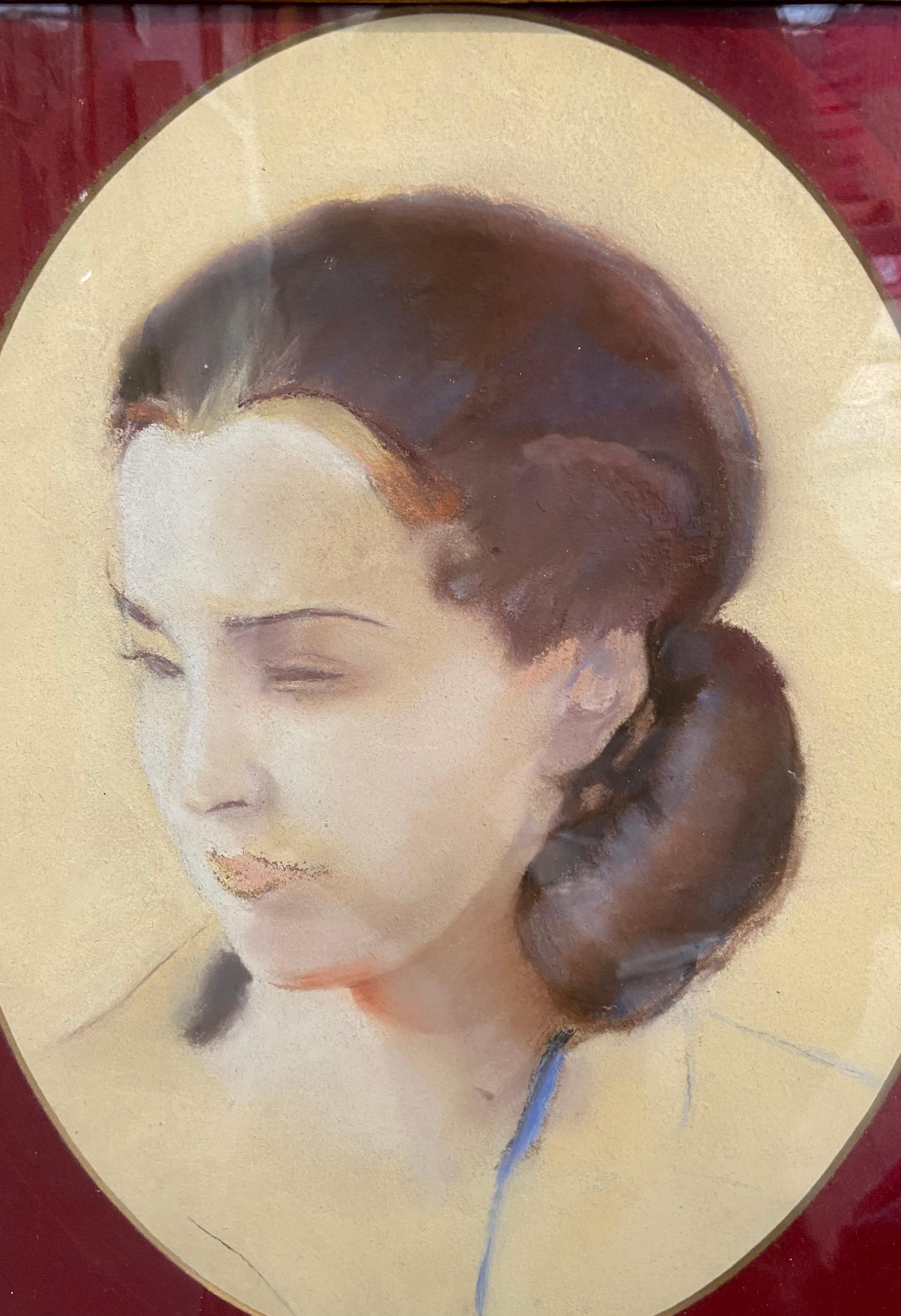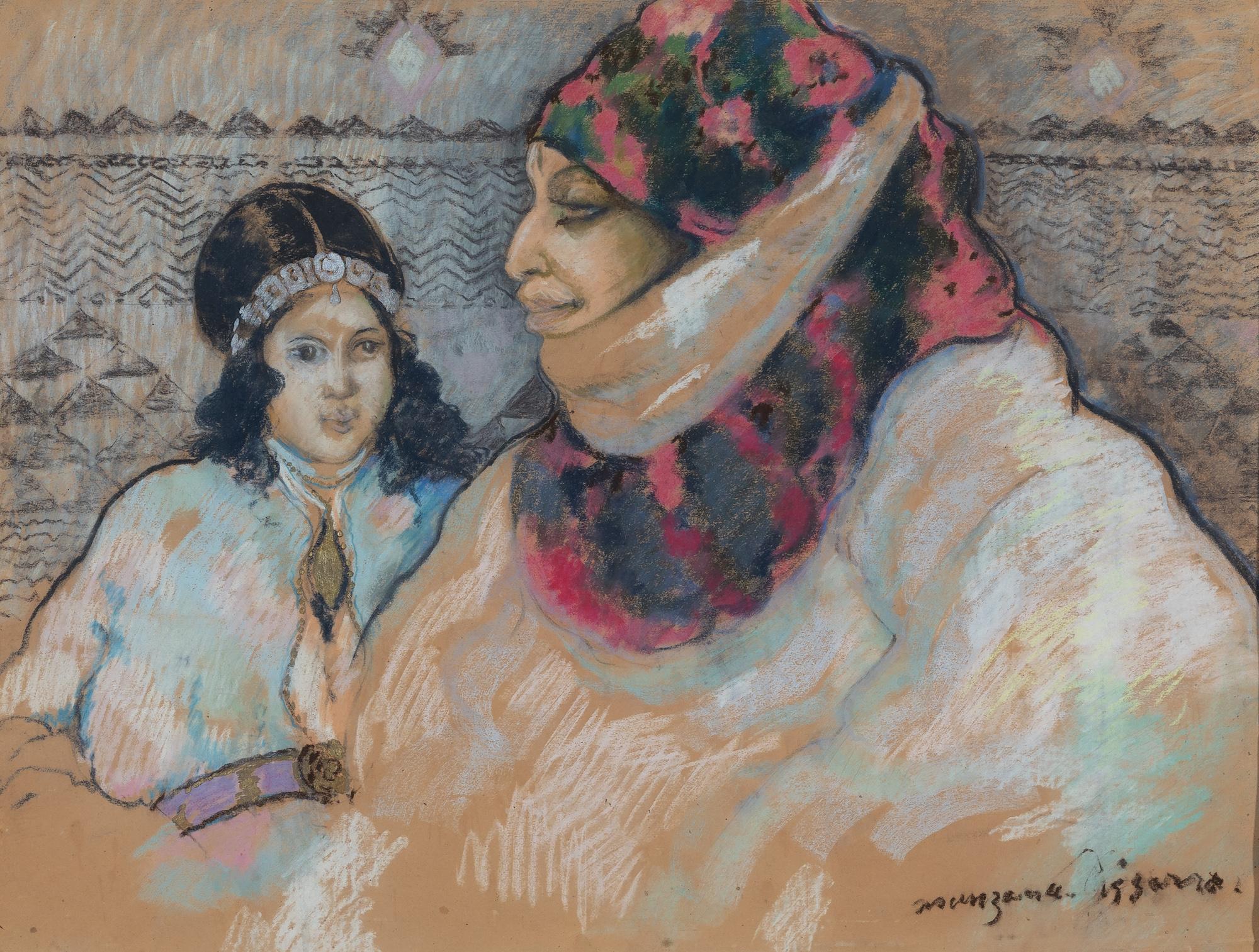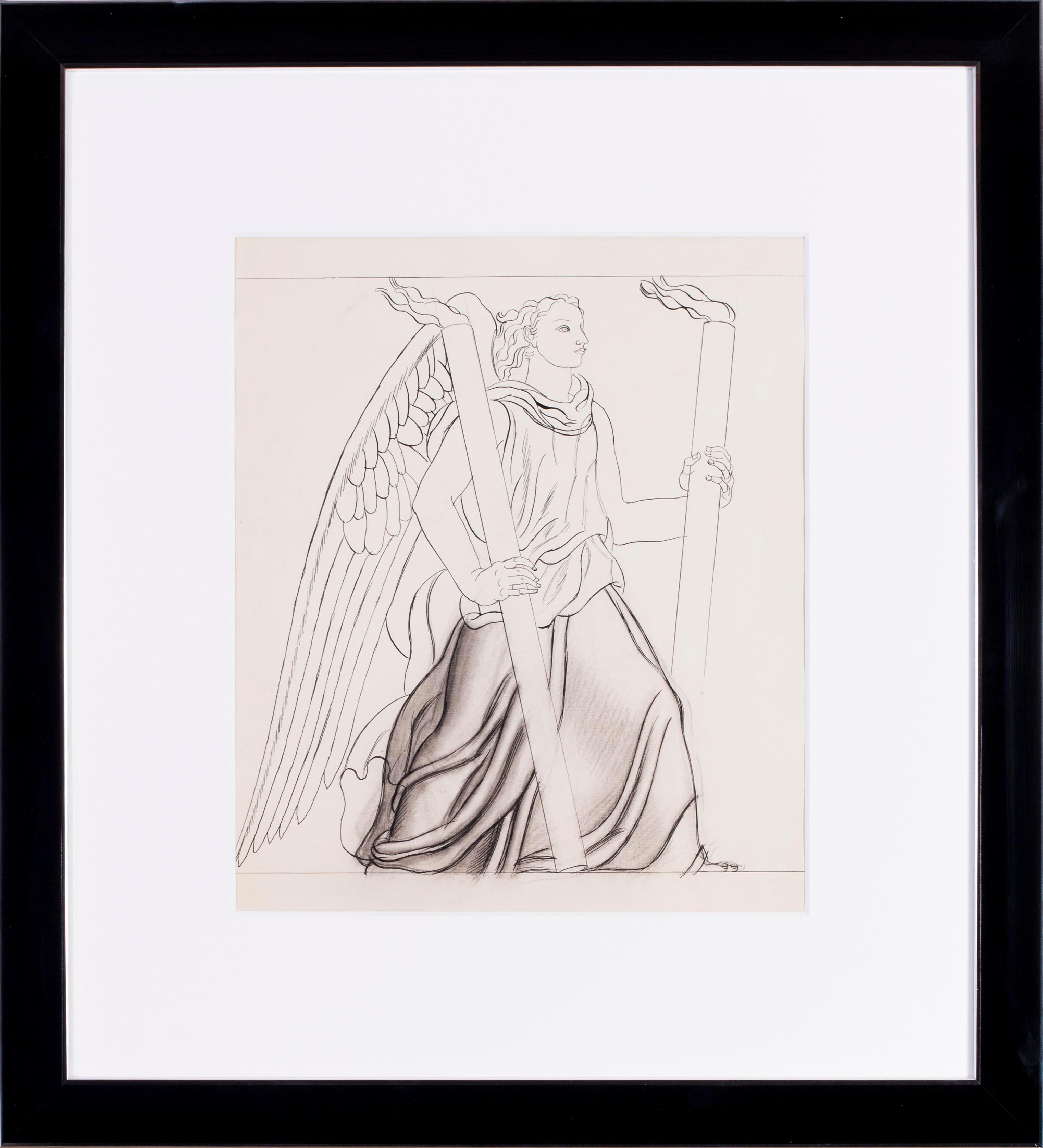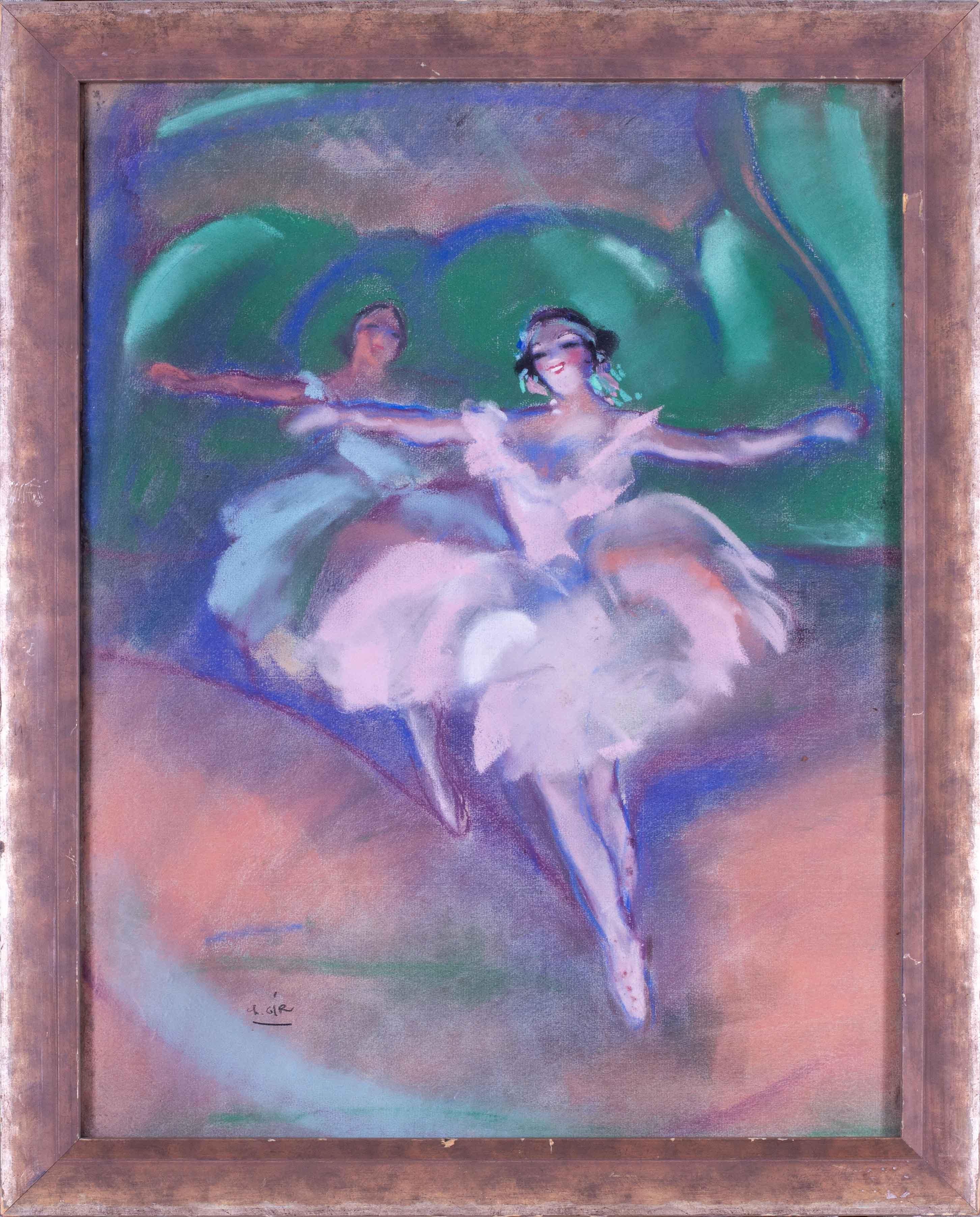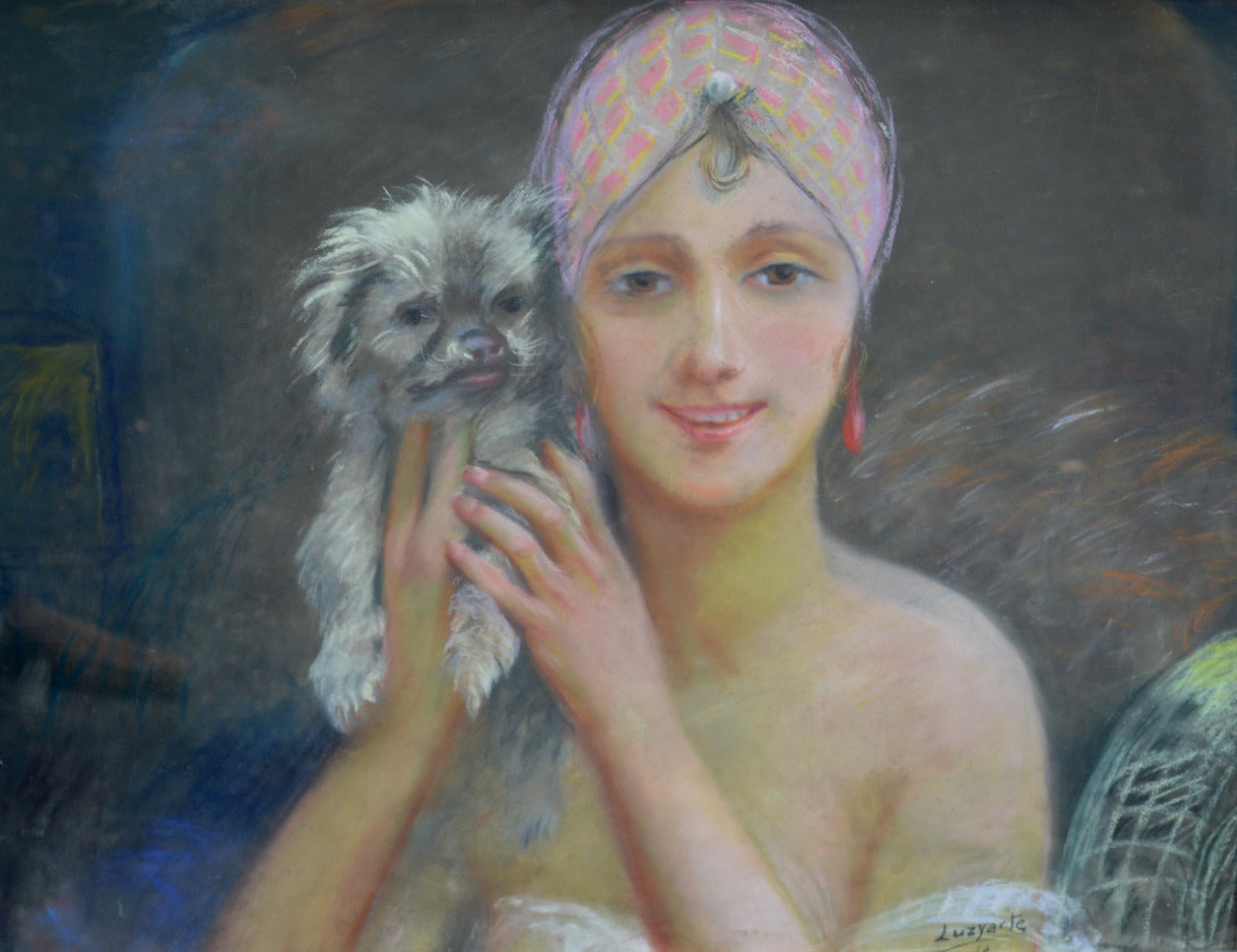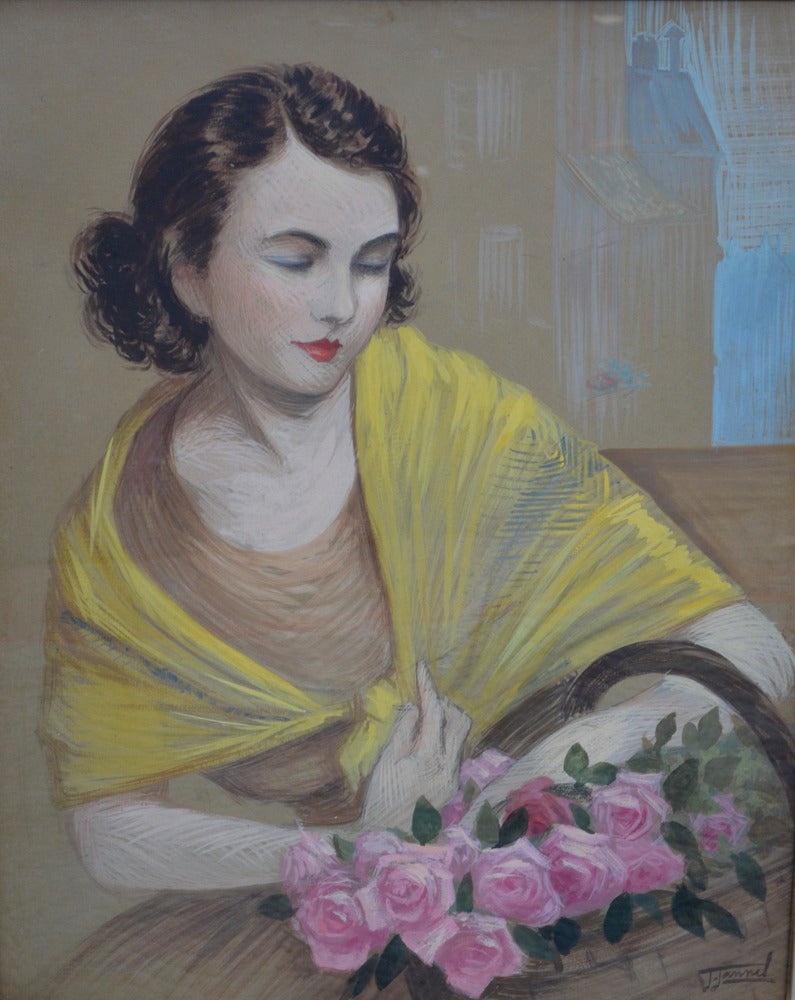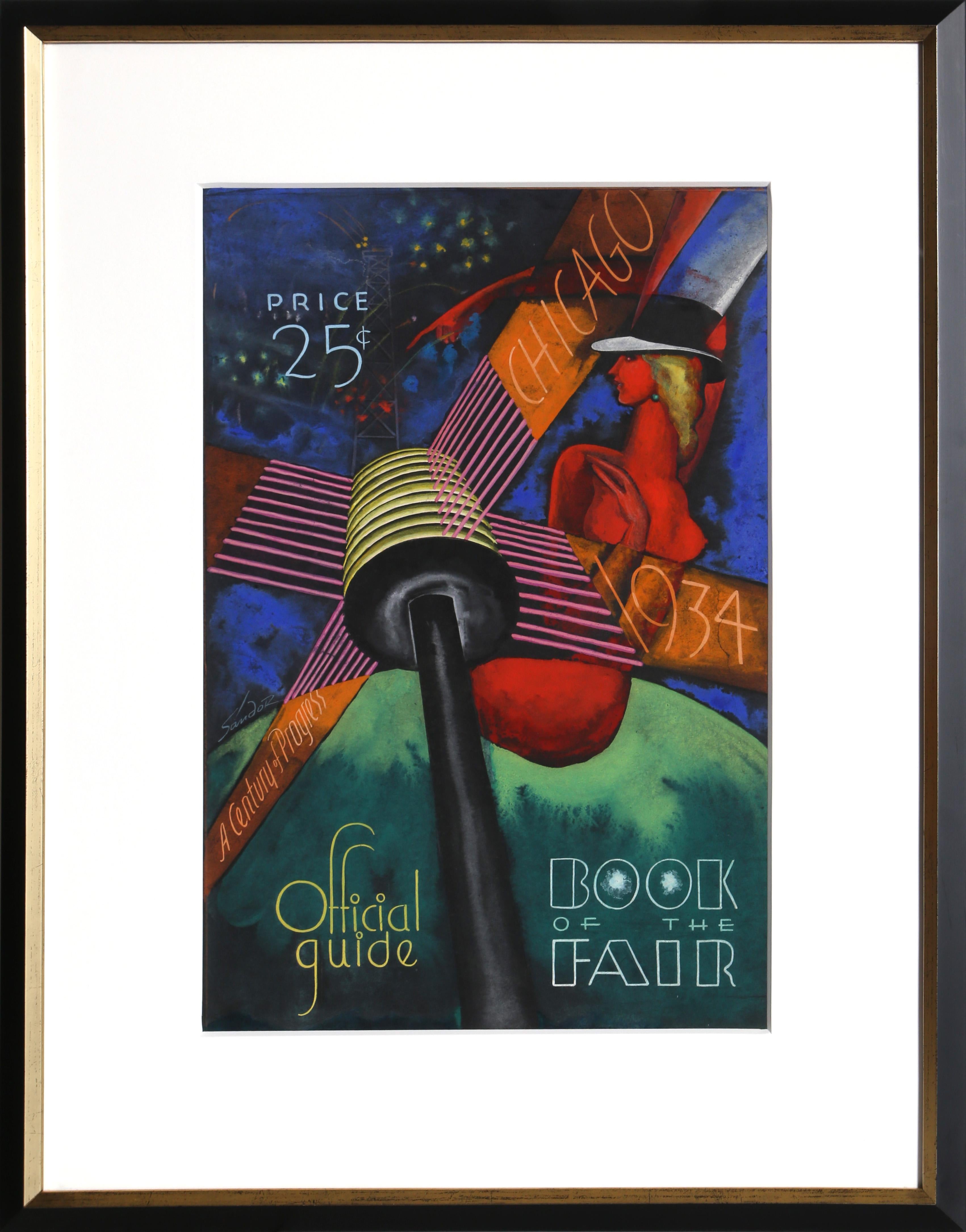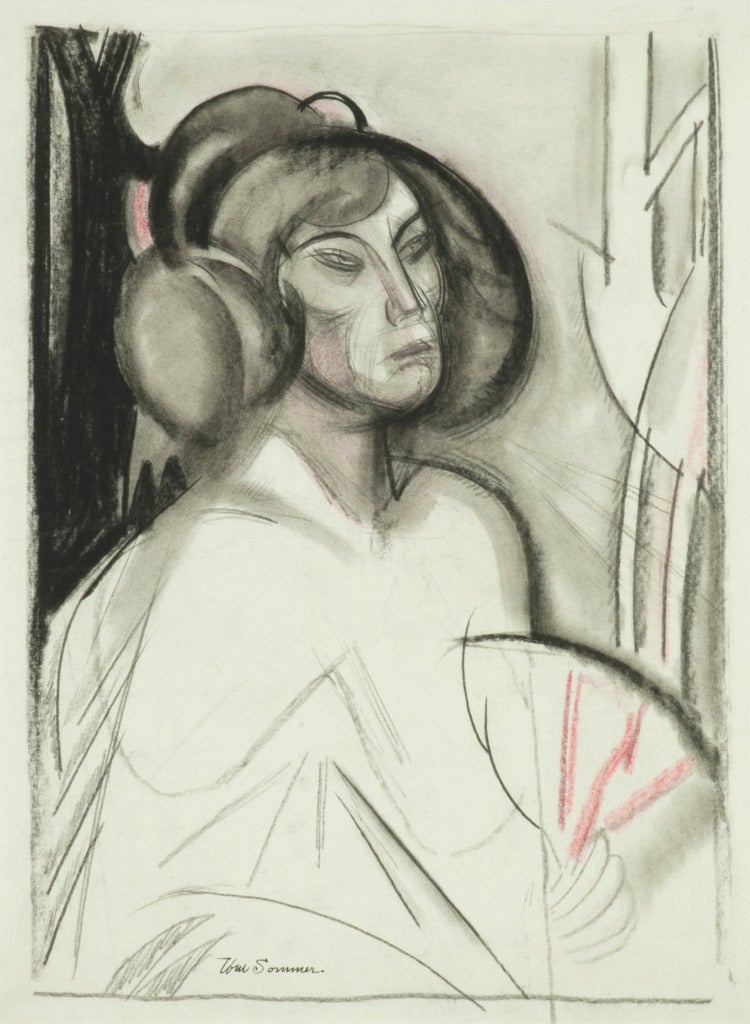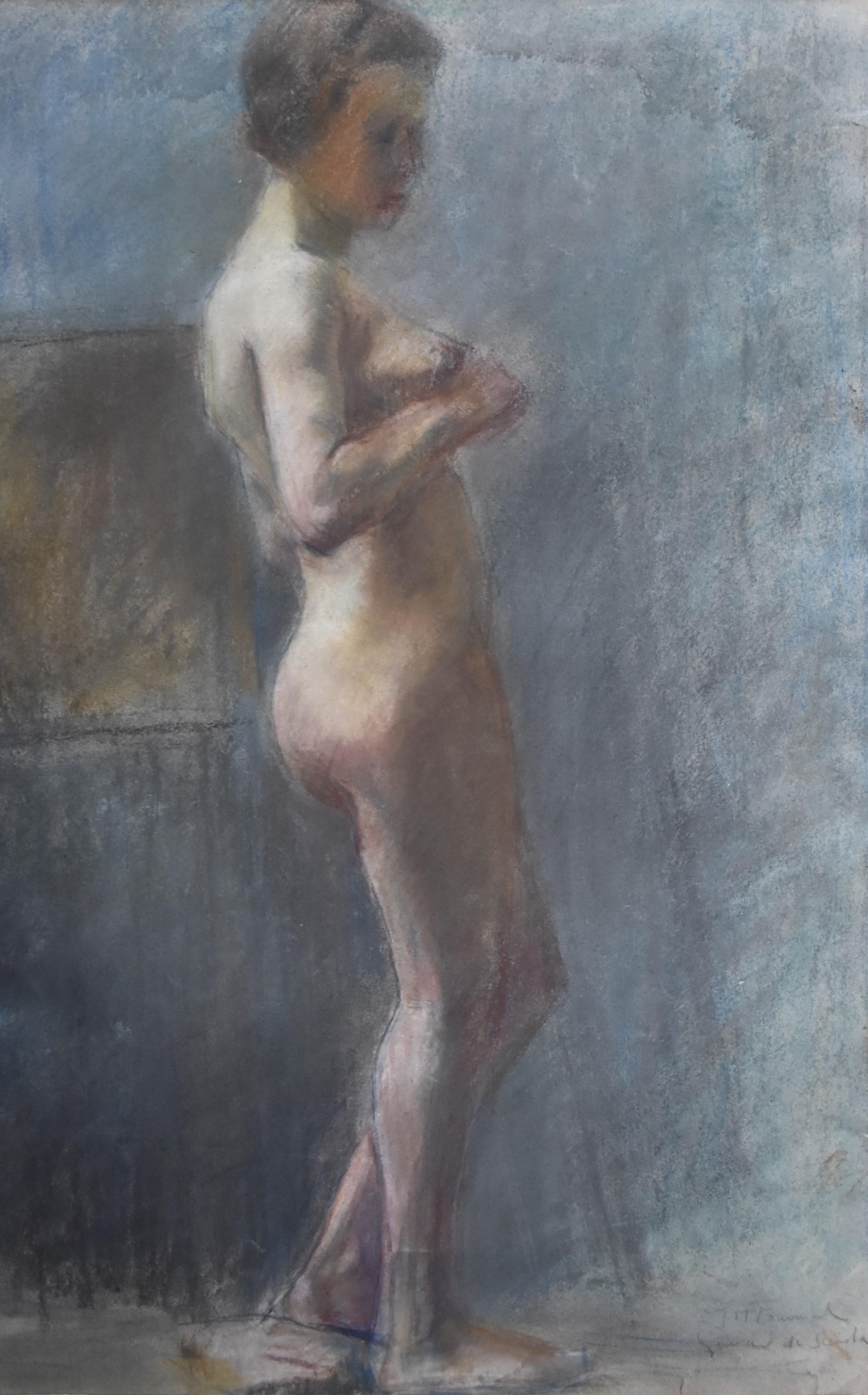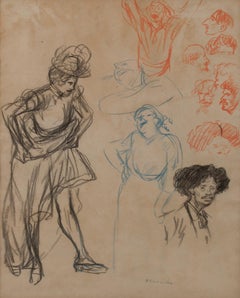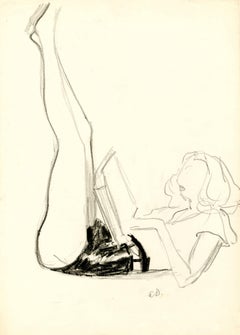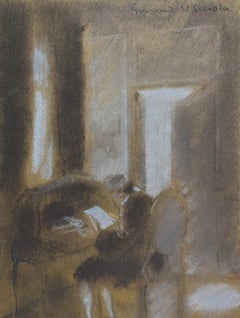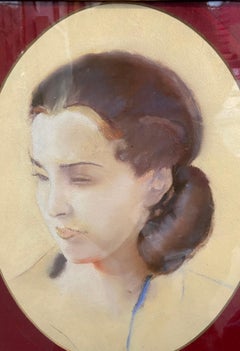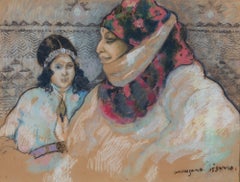
Deco Woman
View Similar Items
Want more images or videos?
Request additional images or videos from the seller
1 of 9
William SommerDeco Womanc. 1918-20
c. 1918-20
About the Item
- Creator:William Sommer (1867-1949, American)
- Creation Year:c. 1918-20
- Dimensions:Height: 15.25 in (38.74 cm)Width: 11 in (27.94 cm)
- Medium:
- Movement & Style:
- Period:
- Condition:Original.
- Gallery Location:Fairlawn, OH
- Reference Number:Seller: FA89131stDibs: G140324140447
William Sommer
William Sommer is seen as a key person in bringing European modernism to Northeast Ohio. He was born in Detroit, Michigan, and in his youth apprenticed for seven years to a lithographer. He briefly studied at an art academy in Germany and then worked as a lithographer in New York before moving to Cleveland, where he was awarded a major contract with the Otis Lithography Company. There he became friends with sculptor and painter William Zorach, and the two, determined to be fine artists, began painting together on weekends. They also became intrigued by avant-garde movements, especially after Zorach's trip to Paris in 1910. In 1911, Sommer co-founded a group in Cleveland called the Kokoon Club, a mixed group of commercial artists and radical modernists who sought the freedom to pursue their independent tendencies. They converted a tailor's shop into a studio and held exhibitions and lectures and organized an annual masked ball that became the focus of Cleveland's bohemian life. In 1913, he and his colleagues began painting at Brandywine, about 30 miles south of Cleveland and made a school house into a studio. They devoted increasing time to watercolor painting because they could work spontaneously and it would dry quickly. Rejecting the conventional ideas of beauty, they strove for the expression of emotion and spontaneity and fantasy. One of Sommer's most successful students was Charles Burchfield. As he was perfecting his mature style, he had financial difficulties because he made his living from commercial lithography, which was becoming obsolete, and the Depression was hitting the nation causing him to lose his job. He became a WPA artist, doing murals in northeastern Ohio. After his death at age 82, he was largely forgotten until 1980 when Hilton Kramer, a "New York Times" critic, praised his work. In May to July, 1994, the Ohio Arts Council held a retrospective of his work at the Riffe Gallery in Columbus. His work is found in many public collections including the National Museum of American Art, The Metropolitan Museum of Art, and the Whitney Museum of American Art.
About the Seller
5.0
Recognized Seller
These prestigious sellers are industry leaders and represent the highest echelon for item quality and design.
Platinum Seller
These expertly vetted sellers are 1stDibs' most experienced sellers and are rated highest by our customers.
Established in 1978
1stDibs seller since 2013
713 sales on 1stDibs
Typical response time: 1 hour
Associations
International Fine Print Dealers Association
More From This SellerView All
- Deco WomanBy William SommerLocated in Fairlawn, OHDeco Woman Crayon on paper, c. 1920 Signed in ink lower left: "Wm. Sommer" (see photo) Provenance: Estate of the artist Edwin Sommer (the artist’s son) Jose...Category
1910s Art Deco Drawings and Watercolor Paintings
MaterialsCrayon
- Double sided crayon drawing in colors: Study for "The Shoe" (recto)By Théophile Alexandre SteinlenLocated in Fairlawn, OHDouble sided crayon drawing: Front: Study for "The Shoe" Reverse: Studies of Figures Blue crayon, red and black crayons Image size: 19.25 x 15.375 inches Frame size: 30 x 25 1/2 inches Signed with the estate stamp, Lugt 2312b, recto and verso Annotated on verso in blue pencil: “On Demande des petites femmes...Category
1890s Art Nouveau Figurative Drawings and Watercolors
MaterialsCrayon
- Eileen LakeBy Adolf Arthur DehnLocated in Fairlawn, OHEileen Lake Crayon on paper, early1930's Initialed in pencil lower right (see photo) Titled and annotated verso "Eileen Lake, early 1930s girlfriend" Note: Eileen Hall Lake was an American poet and Adolf Dehn's girlfriend in the early 1930s. Provenance: Estate of the artist By descent Adolf Dehn, American Watercolorist and Printmaker, 1895-1968 Adolf Dehn was an artist who achieved extraordinary artistic heights, but in a very particular artistic sphere—not so much in oil painting as in watercolor and lithography. Long recognized as a master by serious print collectors, he is gradually gaining recognition as a notable and influential figure in the overall history of American art. In the 19th century, with the invention of the rotary press, which made possible enormous print runs, and the development of the popular, mass-market magazines, newspaper and magazine illustration developed into an artistic realm of its own, often surprisingly divorced from the world of museums and art exhibitions, and today remains surprisingly overlooked by most art historians. Dehn in many regards was an outgrowth of this world, although in an unusual way, since as a young man he produced most of his illustrative work not for popular magazines, such as The Saturday Evening Post, but rather for radical journals, such as The Masses or The Liberator, or artistic “little magazines” such as The Dial. This background established the foundation of his outlook, and led later to his unique and distinctive contribution to American graphic art. If there’s a distinctive quality to his work, it was his skill in introducing unusual tonal and textural effects into his work, particularly in printmaking but also in watercolor. Jackson Pollock seems to have been one of many notable artists who were influenced by his techniques. Early Years, 1895-1922 For an artist largely remembered for scenes of Vienna and Paris, Adolf Dehn’s background was a surprising one. Born in Waterville, Minnesota, on November 22, 1895, Dehn was the descendent of farmers who had emigrated from Germany and homesteaded in the region, initially in a one-room log cabin with a dirt floor. Adolf’s father, Arthur Clark Dehn, was a hunter and trapper who took pride that he had no boss but himself, and who had little use for art. Indeed, during Adolf’s boyhood the walls of his bedroom and the space under his bed were filled with the pelts of mink, muskrats and skunks that his father had killed, skinned and stretched on drying boards. It was Adolf’s mother, Emilie Haas Dehn, a faithful member of the German Lutheran Evangelical Church, who encouraged his interest in art, which became apparent early in childhood. Both parents were ardent socialists, and supporters of Eugene Debs. In many ways Dehn’s later artistic achievement was clearly a reaction against the grinding rural poverty of his childhood. After graduating from high school in 1914 at the age of 19—an age not unusual in farming communities at the time, where school attendance was often irregular—Dehn attended the Minneapolis School of Art from 1914 to 1917, whose character followed strongly reflected that of its director, Munich-trained Robert Kohler, an artistic conservative but a social radical. There Dehn joined a group of students who went on to nationally significant careers, including Wanda Gag (later author of best-selling children’s books); John Flanagan (a sculptor notable for his use of direct carving) Harry Gottlieb (a notable social realist and member of the Woodstock Art Colony), Elizabeth Olds (a printmaker and administrator for the WPA), Arnold Blanch (landscape, still-life and figure painter, and member of the Woodstock group), Lucille Lunquist, later Lucille Blanch (also a gifted painter and founder of the Woodstock art colony), and Johan Egilrud (who stayed in Minneapolis and became a journalist and poet). Adolf became particularly close to Wanda Gag (1893-1946), with whom he established an intense but platonic relationship. Two years older than he, Gag was the daughter of a Bohemian artist and decorator, Anton Gag, who had died in 1908. After her husband died, Wanda’s mother, Lizzi Gag, became a helpless invalid, so Wanda was entrusted with the task of raising and financially supporting her six younger siblings. This endowed her with toughness and an independent streak, but nonetheless, when she met Dehn, Wanda was Victorian and conventional in her artistic taste and social values. Dehn was more socially radical, and introduced her to radical ideas about politics and free love, as well as to socialist publications such as The Masses and The Appeal to Reason. Never very interested in oil painting, in Minneapolis Dehn focused on caricature and illustration--often of a humorous or politically radical character. In 1917 both Dehn and Wanda won scholarships to attend the Art Students League, and consequently, in the fall of that year both moved to New York. Dehn’s art education, however, ended in the summer of 1918, shortly after the United States entered World War I, when he was drafted to serve in the U. S. Army. Unwilling to fight, he applied for status as a conscientious objector, but was first imprisoned, then segregated in semi-imprisonment with other Pacifists, until the war ended. The abuse he suffered at this time may well explain his later withdrawal from taking political stands or making art of an overtly political nature. After his release from the army, Dehn returned to New York where he fell under the spell of the radical cartoonist Boardman Robinson and produced his first lithographs. He also finally consummated his sexual relationship with Wanda Gag. The Years in Europe: 1922-1929 In September of 1921, however, he abruptly departed for Europe, arriving in Paris and then moving on to Vienna. There in the winter of 1922 he fell in love with a Russian dancer, Mura Zipperovitch, ending his seven-year relationship with Wanda Gag. He and Mura were married in 1926. It was also in Vienna that he produced his first notable artistic work. Influenced by European artists such as Jules Pascin and Georg Grosz, Dehn began producing drawings of people in cafes, streets, and parks, which while mostly executed in his studio, were based on spontaneous life studies and have an expressive, sometimes almost childishly wandering quality of line. The mixture of sophistication and naiveté in these drawings was new to American audiences, as was the raciness of their subject matter, which often featured pleasure-seekers, prostitutes or scenes of sexual dalliance, presented with a strong element of caricature. Some of these drawings contain an element of social criticism, reminiscent of that found in the work of George Grosz, although Dehn’s work tended to focus on humorous commentary rather than savagely attacking his subjects or making a partisan political statement. Many Americans, including some who had originally been supporters of Dehn such as Boardman Robinson, were shocked by these European drawings, although George Grocz (who became a friend of the artist in this period) admired them, and recognized that Dehn could also bring a new vision to America subject matter. As he told Dehn: “You will do things in America which haven’t been done, which need to be done, which only you can do—as far at least as I know America.” A key factor in Dehn’s artistic evolution at this time was his association with Scofield Thayer...Category
1930s American Realist Figurative Drawings and Watercolors
MaterialsOil Crayon
- Untitled (Joe and Patsy LoGuidice at the Casa Luna)By Larry RiversLocated in Fairlawn, OHUntitled (Joe and Patsy LoGuidice at the Casa Luna) Pastel, charcoal and colored pencil, 1970-1975 Signed lower right in pencil: Larry Rivers Inscribed on the rabbit of the original white frame: LOGUIDICE in ink Provenance: Private Collection, New York (Westchester County) Condition: Excellent Image size: 31 1/2 x 24 1/2 inches Frame size: 39 1/2 x 32 1/2 inches Note: The image depicts Ciprian “Joe” LoGuidice (d. 2008) and his wife Patsy with their dog (Golden Retriever?) in their famous house Casa Luna, located in Zihautenajo, Mexico. Joe LoGuidice had a most colorful life as stated in his memorial posting by Pam Barkentin: Ciprian "Joe" LoGiudice, of Los Angeles and Zihautanejo, Mexico Art Dealer, Political Activist, Environmentalist, Film Producer, and Executor of the Terry Southern Estate died at home in Los Angeles on September 3, 2008. A major benefactor of the Chicago Seven, he hosted a benefit for the anti-war activists at his Ontario Street Gallery in Chicago and later harbored the fugitive Abbie Hoffman in Zihautenajo where Joe designed and built the famous Casa Luna, the house without walls, in a compound that included Larry River's Studio as well as the garden where Julian Schnabel painted with the assistance of Ramon Pedrazo, Joe's gardener and the husband of his faithful housekeeper, Concha Pedrazo. Here at Casa Luna, from the early seventies on, Joe and his wife, Patsy, generously hosted friends and enemies alike with great enthusiasm and humor.Most recently, through his participation in "Save the Bay", Joe was instrumental in preventing cruise ships from anchoring in the Bay of Zihautanejo. He was also producing "Five Easy Steps to Metaphysical Fitness", a documentary about the philosopher/comic, Emily Levine. Christo's first wrapping of a building in the United States, the Chicago Museum of Art, was produced by LoGiudice. Other artists he represented, in both his Chicago and New York Galleries, included John Chamberlin, Larry Poons, Mark de Suvero, Leon Golub and Jules Olitski. Joe is survived by his wife of 25 years, Patsy Cummings. An important work by Rivers showing his friend and art dealer in their famous house, Casa Luna, in Mexico. The cultural import of LoGuidice cannot be understated. He was a major figure in the New York, Chicago, and Los Angeles art cultures. The artist’s who were his friends and guests were many of the leading icons of late 20th century art. Larry Rivers Larry Rivers in 1961 Born Yitzroch Loiza Grossberg August 17, 1923 Bronx, New York, U.S. Died August 14, 2002 (aged 78) Southampton, New York, U.S. Nationality American Education Hans Hofmann School Known for Painting, sculpture Movement East Coast figurative painting, new realism, pop art Spouse(s) Augusta Berger (m. 1945; div. 1946) Clarice Price (m. 1961; sep. 1967) Larry Rivers (born Yitzroch Loiza Grossberg, August 17, 1923 – August 14, 2002) was an American artist, musician, filmmaker and occasional actor. Rivers resided and maintained studios in New York City, Southampton, Long Island, and Zihuatanejo, Mexico. Early life Larry Rivers was born in the Bronx to Samuel and Sonya Grossberg, Jewish immigrants from Ukraine. From 1940–1945 he worked as a jazz saxophonist in New York City, changing his name to Larry Rivers in 1940 after being introduced as "Larry Rivers and the Mudcats" at a local pub. He studied at the Juilliard School of Music in 1945–46, along with Miles Davis, with whom he remained friends until Davis's death in 1991. Training and career Larry Rivers in 1961 Rivers is considered by many scholars to be the "Godfather" and "Grandfather" of Pop art, because he was one of the first artists to really merge non-objective, non-narrative art with narrative and objective abstraction. Rivers took up painting in 1945 and studied at the Hans Hofmann School from 1947–48. He earned a BA in art education from New York University in 1951. He was a pop artist of the New York School, reproducing everyday objects of American popular culture as art. He was one of eleven New York artists featured in the opening exhibition at the Terrain Gallery in 1955. During the early 1960s Rivers lived in the Hotel Chelsea, notable for its artistic residents such as Bob Dylan, Janis Joplin, Leonard Cohen, Arthur C. Clarke, Dylan Thomas, Sid Vicious and multiple people associated with Andy Warhol's Factory and where he brought several of his French nouveau réalistes friends like Yves Klein who wrote there in April 1961 his Manifeste de l'hôtel Chelsea, Arman, Martial Raysse, Jean Tinguely, Niki de Saint-Phalle, Christo, Daniel Spoerri or Alain Jacquet, several of whom left, like him, some pieces of art in the lobby of the hotel for payment of their rooms. In 1965 Rivers had his first comprehensive retrospective in five important American museums. His final work for the exhibition was The History of the Russian Revolution, which was later on extended permanent display at the Hirshhorn Museum and Sculpture Garden in Washington, DC. During 1967 he was in London collaborating with the American painter Howard Kanovitz. In 1968, Rivers traveled to Africa for a second time with Pierre Dominique Gaisseau to finish their documentary Africa and I, which was a part of the groundbreaking NBC series Experiments in Television. During this trip they narrowly escaped execution as suspected mercenaries.[citation needed] During the 1970s Rivers worked closely with Diana Molinari and Michel Auder on many video tape projects, including the infamous Tits, and also worked in neon. Rivers's legs appeared in John Lennon and Yoko Ono's 1971 film Up Your Legs Forever. Personal life Rivers married Augusta Berger in 1945, and they had one son, Steven. Rivers also adopted Berger's son from a previous relationship, Joseph, and reared both children after the couple divorced. He married Clarice Price in 1961, a Welsh school teacher who cared for his two sons. Rivers and Clarice Price had two daughters, Gwynne and Emma. After six years, they separated. Shortly after, he lived and collaborated with Diana Molinari, who featured in many of his works of the 1970s. After that Rivers lived with Sheila Lanham, a Baltimore artist...Category
1970s Contemporary Figurative Drawings and Watercolors
MaterialsPastel
- Getting Ready for the Revolution - Learning How to Ride in the SubwayBy Adolf Arthur DehnLocated in Fairlawn, OHGetting Ready for the Revolution - Learning How to Ride in the Subway Litho crayons on illustrator’s board, c. 1932 Signed: Adolf Dehn (VED) lower right corner (signed by Virginia De...Category
1930s American Modern Figurative Drawings and Watercolors
MaterialsOil Crayon
- CourtshipBy Robert HenriLocated in Fairlawn, OHCourtship Graphite and black crayon, c. 1905 Signed by the artist in pencil lower left (see photo) Most probably inspired by a Paul Gavarni lithograph and executed while the artist w...Category
Early 1900s American Impressionist Figurative Drawings and Watercolors
MaterialsCrayon
You May Also Like
- L V Guirand de Scevola (1871-1950) A Man writing at his desk , Signed pastelBy Lucien-Victor Guirand de ScévolaLocated in Paris, FRLucien-Victor Guirand de Scevola (1871-1950) A Man writing at his desk, 18th century interior scene Pastel on paper Signed upper right 20.5 x 15.8 cm Framed under glass : 37 x 31.5 cm It is known that Guirand de Scevola was very interested in the Palace of Versailles and its Old Regime atmosphere, that he often painted it and that he participated in the Versailles Revival movement at the beginning of the century. This probably led him to paint scenes in the 18th century style, for which he was particularly well known and which are still sought after. What is striking is the modernity of the execution of our pastel, which obviously contrasts with its subject in the style of the 18th century. Guirand de Scevoal is a great colourist and he proves it here with eclat, by building up his composition with white pastel highlights, contrasting with brown and black. There is something of the northern painters in this treatment of light. All this, as always with him, is very subtle. The light radiating from the window is almost an abstract notation, but it gives meaning to this interior scene. Lucien-Victor Guirand de Scévola ( 1871 – 1950) was a French painter. He was student of Fernand Cormon and Pierre Dupuis...Category
1920s Art Deco Interior Drawings and Watercolors
MaterialsPastel
- L V Guirand de Scevola (1871-1950) Portrait of a young woman, 1928, oval pastelBy Lucien-Victor Guirand de ScévolaLocated in Paris, FRLucien-Victor Guirand de Scevola (1871-1950) Portrait of a young woman Pastel on paper 38 x 28 cm (oval) Framed under glass in a vintage framing : 45 x 35 cm A label on the back "1928 Portrait de femme Etude au pastel de Guirand de Scévola" (see photographs please) This pastel study is of course not signed, as the label on the back of the frame gives its attribution to Guirand de Scévola and, equally interestingly, the date 1928, but in fact the artist's style and execution are immediately recognisable without the need for a signature. This type of woman with a bun is typical of the models the artist loved. Her mysterious air recalls his Symbolist period, and pastel is hisr preferred medium because it lends itself to all the characteristics typical of his art. Lucien-Victor Guirand de Scévola ( 1871 – 1950) was a French painter. He was student of Fernand Cormon and Pierre Dupuis...Category
1920s Art Deco Portrait Drawings and Watercolors
MaterialsPastel
- Moroccan Woman with Girl by Georges Manzana Pissarro - Work on paperBy Georges Manzana PissarroLocated in London, GBMoroccan Woman with Girl, Pastel with Gold and Silver on Paper Pastel with gold and silver on paper 47 x 62cm (18 ½ x 24 ⅜ inches) Signed lower right, Manzana Pissarro Painted circa ...Category
1940s Art Deco Figurative Drawings and Watercolors
MaterialsPaper, Pastel
- Jean Dupas art deco drawing, 'The Angel of light'By Jean DupasLocated in Petworth, West SussexJean Dupas (French, 1882 – 1964) The angel of light Pen and ink and charcoal on paper 14.3/4 x 12.1/2 in. (37.5 x 31.8 cm.) One of the leading artists of the Art Deco period, Jean Théodore Dupas was the son of a merchant marine captain and began his adult life as a merchant seaman. Poor health meant that he had to abandon this career and he enrolled in art school instead, first in his native Bordeaux and later in Paris. He won the Prix de Rome in the category of painting in 1910 and studied at the Académie de France in Rome, from where he sent several paintings to the Paris Salons, although his studies were interrupted by the outbreak of war. Dupas’s work came to public prominence on the occasion of the seminal Exposition des Arts Décoratifs in Paris in 1925. He was chosen by the furniture designer Jacques-Emile Ruhlmann to provide paintings for the latter’s Maison d’un collectionneur, alongside furniture by Ruhlmann and objects by many of the leading Art Deco craftsmen of the day, while other paintings by Dupas were also displayed to great effect elsewhere in the Exposition. In the late 1920’s and 1930’s Dupas won a number of important and prestigious commissions. In 1926 he worked alongside Ruhlmann and the sculptor Alfred Jeanniot on the decoration of the tearoom of the ocean liner Ile-de-France; the first of the grand transatlantic ships to be built in France after the First World War. By this time Dupas had firmly established his reputation. Writing in 1927, his fellow artist George Barbier could already note that ‘Few artists have at such an early age attained such a degree of success, or gathered around them such swarms of imitators and disciples.’ Dupas reached the height of his fame in the mid 1930’s, and in 1934 he received his most important commission to date; a series of large glass murals...Category
Early 20th Century Art Deco Figurative Drawings and Watercolors
MaterialsCrayon, Paper, Ink, Pen
- Dans La LogeBy Dimitri BoucheneLocated in London, GBPastel on paper, signed (lower left), 63cm x 49cm (framed 75cm x 60cm). Bouchéne was a Russian artist and costume and set designer for theatre, opera and ballet. Primarily working ...Category
1920s Art Deco Figurative Drawings and Watercolors
MaterialsPaper, Pastel
- Art Deco pastel drawings of ballerinas on point by French artist Charles Gir'Located in Petworth, West SussexCharles Gir (French, 1883 – 1941) Ballerinas on point Pastel on paper Signed ‘CH. Gir’ (lower left) 24 x 18.1/2 in. (61 x 46.8 cm.) Charles Gir was born in Tours, France on November 1, 1883. He was a noted painter, watercolorist, pastellist, sculptor and illustrator. Gir was married to the well-known actress, Jeanne Fusier-Gir, and attended the Paris Opera every night for 17 years. He made many sketches of dancers and caricatures, and at the end of his wife’s performance used to deliver them to the newspapers he worked for. He knew Raoul Dufy, Frances Carco and Jehan Rictus. He sculpted a bronze statue of Don Quixote that now stands near the Prefecture of Cergy-Pontoise; and he also illustrated several books, including Edmond Rostand...Category
20th Century Art Deco Figurative Drawings and Watercolors
MaterialsPastel, Paper

